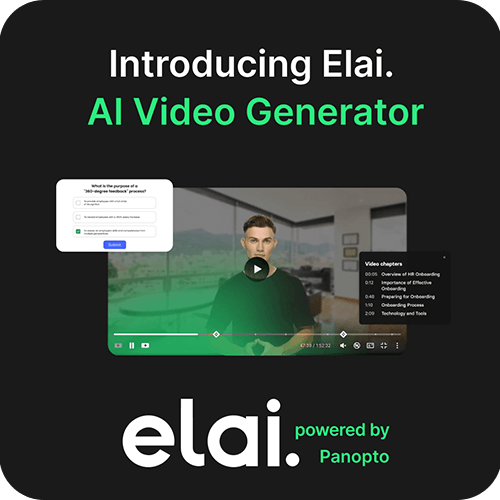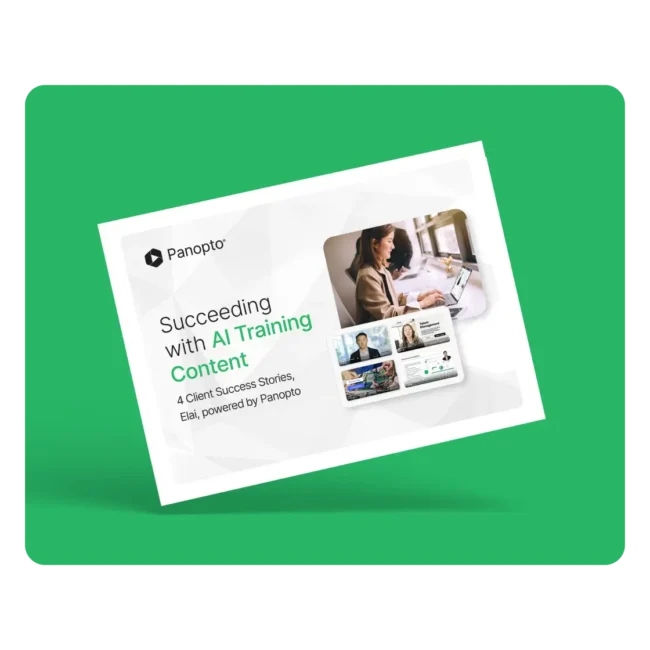- Academic Technology
How Are Universities Using Video On Campus?

Over the past 10 years of Panopto, we’ve seen our university user community adopt our video platform in a range of exciting and innovative ways. We wanted to highlight ten key ways to use our system in an educational context – some very mainstream and others a little more off the beaten path. We hope this will give you ideas and inspiration for your own future experiments with video.
#1 Lecture capture
Lecture capture is the most established and widespread use for Panopto in higher education. As mainstream as this use case is though, we see a wide array of approaches to the lecture recording process amongst our customer base.
Some institutions let lecturers activate recordings manually, while others automate lecture capture using our remote recorder functionality. Some have implemented lecture capture campus-wide while others initially choose to focus lecture recording within certain departments or use it for certain disciplines. Some instructors record just audio with slides or a screen while others integrate video of them presenting into their sessions. Some host lecture videos in the cloud, others deploy Panopto on-premises in their own data centers.
We recently summarised a range of these different ways of thinking about lecture capture setups in a white paper on how to facilitate recording in any teaching space. This resource gives a comprehensive overview as to the ‘how’s’ surrounding lecture capture implementation.
But what about the ‘why’s?’ Why are so many institutions now providing their students with on-demand lecture recordings? Well, there are three key reasons that we hear again and again from customers as to why lecture recording is so important. These are:
- To enhance student satisfaction. A recent case study from Copenhagen Business School offers insights from their student surveys into why their learners think recorded lectures enhance their educational experience. In the words of one student: “All lectures should be recorded, it’s a really big help when you study for the exam.”
- To offer better provision for students with disabilities, medical conditions or other commitments that sometimes make it impossible for them to attend classes physically. Accessibility and inclusivity are becoming ever more important drivers for the adoption of lecture capture technology.
- To improve student learning outcomes. Our analytics show that students make the most ample use of Panopto recordings during exam season to enhance their revision efforts.
Rowan South, Education Officer at Newcastle University Student Union recently outlined why on-demand lecture recordings are so valuable to their students. Read more about results of his lecture capture research.
Watch a lecture captured with Panopto below:
#2 Video content management
Panopto includes a video content management system (video CMS) that many of our higher education customers use as a central video library for lecture recordings. By creating a centralised video repository with LMS or VLE integration and taking advantage of unlimited storage, universities are now thinking about next steps like offering post-graduation access to videos for alumni.
Keith Vallis, Director of Curriculum – ICT at Barker College describes the rationale behind this approach and the advantages to having one core video library:
“I’ve been able to aggregate all my existing training videos from various external repositories and our own school server into one centralised and secure location. I can then edit and combine various sections in situ, and create snippets, clips and highlights quite easily, as well as being able to control who sees them.”
For staff at Barker College, aggregating video content into one central, secure system with fine-grained permissions levels was critical in delivering the video experience they wanted to provide their students. Read more about how Barker College uses Panopto for video content management in our case study.
#3 Flipping the classroom
The fastest-growing use for Panopto in higher education is to facilitate the flipped classroom. The ‘standard’ flipped classroom model has students watch a video lecture before class in order to participate in a discussion, group work, or other activities during the session in which the lecture would have taken place.
There are several different spins on the flipped classroom. These include:
- The standard inverted classroom
- The discussion-oriented flipped classroom
- The demonstration-focused flipped classroom
- The faux-flipped classroom
- The group-based flipped classroom
- The virtual flipped classroom
- Flipping the teacher
Related Reading: 7 Unique Flipped Classroom Models – Which Is Right For You?
Two of the less well-known variations on the flipped classroom are the faux-flipped classroom and flipping the teacher.
In a faux-flipped classroom model, students watch a short recorded lecture video actually in class — giving them the opportunity to pause and rewind the lecture at will, learning at their own pace. The lecturer is able to move from student to student to answer questions and offer whatever individual support each learner needs as they review the course videos.
Institutions that are experimenting with flipping the teacher are essentially putting students right at the centre of the learning experience. In this approach, students are asked to do short recordings on a topic and share these with the lecturer in advance of class. The instructor can then respond to these recordings in the live session.
Why is the flipped classroom approach so popular? Well, it’s great if you want to do any of the following:
- Unpack complex concepts in advance for students to absorb at their own pace
- Free up more class time for instructor-led active learning
- Encourage greater student participation in their learning journey
In the words of Dr Jeremy Pritchard, Senior Lecturer and Head of Education, School of Biosciences at the University of Birmingham, who introduced his students to flipped learning:
“I was interested in how you can use new teaching approaches to put some of the responsibility back on the student and open up time for more group work that will build students’ transferable skills.”
Watch a flipped laboratory video recorded with Panopto:
#4 How-to videos or video tutorials
Our higher education customers also frequently use Panopto to create how-to videos or video tutorials. How-to videos tend to fall into one of two categories:
- How-to videos that impart practical skills or enhance the student experience. For example:
- Onboarding videos for incoming first-year students
- Recordings that unpack exam rubric
- Explainer videos that teach students or staff about key university systems.
- Tutorial videos that relate to specific elements within a course or discipline. For instance:
- Videos of laboratory demonstrations with multiple camera angles
- Tutorials on musical techniques
- Demos of software packages students will need to use as part of their course
A survey we undertook with youth trend experts Voxburner showed that 78% of students already use online video platforms like YouTube and Vimeo to teach themselves various skills, ranging from teaching themselves a practical DIY technique to learning how to budget for university. Ultimately, universities are creating libraries of both university and student resources in the form of high-quality how-to videos — it’s an adaptive strategy that engages today’s students with the format they use the most for learning.
#5 Distance learning
Video lends itself perfectly to this form of learning, so it’s no surprise that a huge proportion of Panopto users are supporting distance learning with our platform. They are doing this by using a range of Panopto’s functionality, including:
- Webcasting physical lectures to give distance learners an almost exact equivalent of what campus-based students are experiencing.
- Providing purely digital resources for distance learners to view on-demand.
- Encouraging interaction between distance and face-to-face learners with our interactive video player that allows collaborative note-taking.
Panopto’s video platform makes it possible to connect learners from across the world while humanising the virtual learning experience, subsequently increasing levels of engagement. By offering distance learners enhanced video resources, universities are able to expand access to higher learning and also increase student satisfaction.
#6 Live broadcasting
Universities are using Panopto to live stream classes, events and more, including:
- Streaming live lectures to overflow classrooms
- Live broadcasting graduation ceremonies
- Sharing guest lectures with external audiences
- Hosting ‘live lounges’ for music performances or concerts
Similar to how Panopto supports distance learning, the key advantages of live broadcasting enable universities to deliver content at scale and to expand access beyond the physical campus, offering a ‘humanised’ digital experience that makes both existing and new audiences feel like they’re there. For performance-based live broadcasts, like concerts and recitals, it also allows colleges to showcase the talents of their students.
When Kettering University asked itself, “How can we better serve the needs of our non-local students and their families,” it discovered that it could easily use Panopto to broadcast live events that would help its expanding student body of distance learners feel more connected to the school. Read more about how Kettering used Panopto to live stream its graduation ceremony with just two weeks to prepare in our case study.
#7 Giving feedback on student assignments through video
Video feedback is one way many instructors are using Panopto to enhance traditional marking techniques, capturing the nuanced tone of their assessments rather than scribbling shorthand notes on assignments.
For example, an instructor would use Panopto to show the student’s essay on her laptop screen and record her commentary with her built-in webcam and microphone, talking through positives and negatives as she scrolls through the document.
Others have used Panopto’s mobile recording functionality to provide compelling student feedback. For instance, a lecturer on the University of Derby’s Fashion BA used Panopto’s iPad app to record video feedback about students’ garments. Read more about this unique use case here.
Why are institutions doing this? Well, not only do students love it, but academics also say it enables them to give better, richer feedback. Dr Daniel Moore, a Lecturer in Modern and Contemporary Literature from the University of Birmingham explained his reasoning for offering this kind of video feedback:
“From a tutor’s perspective, video feedback was seen as a great time saver, with staff reporting that when they switched to video feedback, the average time spent on the whole process was reduced by 10-25%. As well as saving time, tutors also saw pedagogic benefits. In certain instances, tutors felt that they could verbally provide critique that might seem overly harsh when simply written down.”
Read more about how Panopto is used at University of Birmingham to deliver student feedback.
#8 Student recording
There are a couple of ways universities tend to use Panopto to record student presentations. Sometimes academics manage the recording setup themselves, allowing students to focus on just presenting or performing. Other times, students produce the recordings themselves, often using Panopto’s mobile apps, and upload them into the Panopto video platform.
Panopto is used across a number of different disciplines to record students. The following are just a few examples:
- Business students perfect their ability to present and pitch by watching recordings of their presentations back.
- Geology students gain confidence in advance of an oral examination, practising via video.
- Music students record themselves (or are recorded) performing. This might be for assessment, self- or peer review.
Watch a multi-camera recording of a piano performance by Luke Hawkins, an MA Performance student at University of Chichester, captured with Panopto.
Here are just some of the advantages academics cite as reasons for incorporating student recordings and video-based student assignments into their curricula:
- Video for student self-reflection is key in some practical subjects, where to be able to see what you are doing is critical to improvement.
- Video-based coursework can help build students’ digital literacy.
- Students with great presentation skills (as opposed to writing skills) have a chance to shine.
- Students have the opportunity to build up a video portfolio.
- Having recordings available can make the process of external moderation easier.
#9 Language learning
Panopto makes it easy for anyone to capture high-quality audio and video, and also offers a range of interactive features through its video player — making it a useful learning tool in language courses for both instructors and students.
Teachers can use the platform to show intricate details when communicating in another language such as mouth positions that improve pronunciation. Students can record videos of themselves speaking a language to demonstrate mastery. And Panopto’s interactive video player allows both teachers and students to provide detailed feedback, to ask questions about something very specific at the exact moment in the video, and even for discussions.
23% of students are already using online video portals like YouTube and Vimeo to teach themselves languages, according to a recent survey we did with youth trend experts Voxburner. Language instructors often use Panopto to create instructional video content designed to be used in an academic setting, offering students a similar but higher-quality learning experience than they’d get from watching videos on YouTube.
Keiko Hosogoe, a teacher of Japanese at Barker College in Australia describes how Panopto has enhanced language learning in her classes:
“I use Panopto to record various aspects of my Japanese Language course. My students are able to view and listen to these at home via Panopto to practice the various expressions. This helps with pronunciation and tone. Panopto has given me a fantastic avenue for students to train in the language.”
Watch a video recorded with Panopto of a Spanish language student giving a presentation:
#10 Staff training and staff self-reflection
Many members of the Panopto community use our video platform for recording and storing staff training videos about everything from university systems and processes to HR policies.
Some institutions using Panopto to support staff in other ways, such as actively encouraging them to use Panopto for self-reflection and reviews. At universities that are using Panopto for review and reflection, video content is typically recorded so staff can watch it back and assess their own teaching practice. This can work in a couple of ways:
- Pure self-review. The individual lecturer records her own class and watches it back for to assess from the student perspective.
- Mentor review. Video content is shared with a mentor so he can give constructive feedback. Feedback can be presented face-to-face, but often Panopto is used since it allows the mentor to leave notes at specific times in the video, or the mentor can record his own video relaying feedback if scheduling an in-person meeting is a challenge.
- Peer review. Academics share video content within a department to spread best practices or to offer feedback to their peers.
- ‘Flipped’ self-review. We know of one institution where the staff reflection is ‘flipped,’ which means they record the students while the teacher teaches. It’s a useful approach to assessing student engagement during the instructor’s courses.
What’s the benefit from using video for staff training and development? Video is a quick and easy way to provide consistent training materials and to give them more opportunities to reflect on, and share, best practices.
Thinking Outside The Box
These top ten use cases for campus video are far from an exhaustive list of potential applications. Our customers regularly share the creative and exciting new ways they are enhancing learning with video at their schools, like recording multiple viewpoints in a mock courtroom, capturing patient interactions for immersive medical training, sign language capture to improve accessibility, and even experimenting with virtual and augmented reality for learning. Some schools are even using Panopto to host virtual open days, which enable institutions in remote locations to reach out to prospective students online.
It’s hard to predict what the future holds but we’re excited to see how educators will continue to use video technologies to reshape learning.
If your institution wants to try any of these use cases — or a new one — and you want to explore how Panopto can support you in realising your video project, contact us for a free trial.




